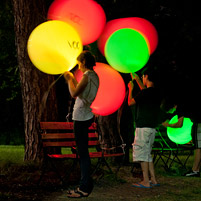Air Quality Balloons

Wondering about the air quality in your own backyard? Students at Carnegie Mellon University have come up with a do-it-yourself (DIY) technology which lets people create air quality balloons that glow yellow, red or green in response to pollution levels.
Each balloon reacts to input from an attached sensor that measures exhaust, diesel or volatile organic compounds (VOCs).
"This project is low-cost and easily replicable by non-experts, and our tutorial on Instructables.com shows how pretty much anyone can make these," said Stacey Kuznetsov, a Ph.D. candidate in CMU's Human-Computer Interaction Institute. "We wanted to create a technology that inspires awareness and participation. Balloons are a vibrant and inherently playful medium for projecting environmental data into the public sphere."
As a field, human-computer interaction is evolving to encompass technology at large and the creation, use and interpretations of technology, Kuznetsov says. "Our work lies at the intersection of expressive technologies, environmental sensing and political activism," she added.
Air quality data is frequently represented through graphs, charts, maps and other conventional means. Kuznetsov wanted to create something that would really draw attention to environmental data in a public, compelling and provocative way."People can ignore a website or a cell phone app, but it's hard to overlook giant glowing balloons — even if you are not initially thinking about or interested in air quality," Kuznetsov said.
Working with her advisor, Eric Paulos, and electrical and computer engineering students Jian Chiu Cheung and George Noel Davis, Kuznetsov organized air quality balloon installations in a public park and along a city block in Pittsburgh. These installations inspired ordinary passersby — people who may not have been initially concerned with air quality — to stop and explore, interact with, and raise concerns about environmental issues.
She loves the freedom and resources available at CMU to pursue creative and provocative projects.
"As an advisor, Eric Paulos is a great inspiration to me. Here at the Living Environments Lab, we are always encouraged to make and build things, to question the current state of the world, and to explore new, evocative and even 'risky' ideas," she said.
By focusing her work on low-cost, DIY technologies, Kuznetsov hopes to inspire ordinary citizens to become more interested and involved in environmental and political issues.
"I hope to develop technologies that empower people to share their concerns, explore environmental issues and enact change," she said.
Related Links: Read the Tutorial | HCII | Environment at Carnegie Mellon
